Our next 8 days were spent cruising around Isabela Island on a 90 ft Catamaran, staffed with 9 crew members (including the captain), serving 12 soles (though there was room for 16).
The ship, The Seaman Journey, was beautiful! The main level housed our cabins, the dining room, bar and salon as well as an aft deck where we disembarked into pangas (dinghies) for daily excursions ashore or for snorkelling.
Before boarding the Seaman Journey, we met our group, who had just arrived from mainland Ecuador a few hours before. All, had been travelling for a week or two before coming to Galapagos. At Ranch El Manzanillo, in the mist covered forests of the Santa Cruz highlands, a taxi driver dropped us off and over lunch, we all became briefly acquainted.
There were two couples travelling together from Long Island, New Jersey USA, and two other couples from Australia and England as well as a mother & son duo from Germany. Paul and I rounded off the group and after lunch, we started out on the first of our many excursions.
..looking for the Galapagos Giant Tortoise!
Before heading out we were warned about the ‘manzanillo’, a small apple-like fruit that grows on the trees in the area, and incidentally the ranch’s namesake, as an abundance of these fruits grow here.
Manzanillos are poisonous to humans, not just the fruit but the sap can cause blistering as well. Although the tortoises have no problem eating them, we were told to be both cognizant and cautious of their presence as we explored the area.
Mindful of the manzanillos we set out to find the Galapagos Giant Tortoise, one of the most famous animals of the Islands. In fact, the Archipelago itself is named after them with ‘Galapágo’ being an old Spanish word for tortoise!How’s that for a fun fact!
The Galápagos Giant Tortoise is said to have arrived in Galapagos from mainland South America 2-3 million years ago. Currently, there are ten living species of giant tortoise remaining in Galapagos with a population estimated at 20,000 individuals.
Of the 10 different species of giant tortoises there are two specific variations, the domed and saddle-backed. Dome-shelled tortoises are close to the neck of the tortoise, restricting the extent to which they can raise their heads. They tend to live on larger, more humid islands where there is lots of vegetation to eat. Saddle-backed tortoises have an upward curve to the front of their shell, which allows them to stretch up to reach higher growing plants. They tend to live on the more arid islands in Galapagos, where food is less abundant.
With maximum length reaching 1.8 meters (aprox. 6 ft) and weighing in at at whopping 400 kg (nearly 900 lbs, maximum), its understandable that the Galapagos Giant Tortoise spends an average of 16 hours per day resting. The rest of their time is spent eating grasses, fruits and cactus pads!
The first giant tortoise we spotted was impressively large. We stopped to take the obligatory photos and spend time oohing and aweing and reluctantly moved on to find another. This went on for a half an hour or so before we spotted a tortoise that fit the bill for the maximum sizes! OMG! Even our guide was blown away!
The tortoises found on Manzanillo Ranch are wild. They come and go at will with their presence only marginally predicted by precipitation as they tend to show up after rainfall to munch on ranch greenery!
When we spotted this enormous giant of a tortoise a quiet fell over our group. At first, collectively, we didn’t even bother raising our cameras. I guess we were so shocked to see a living, breathing tortoise of this enormity, something you only read about in books, that we were all a little too dumbfounded to react.
Quietly and almost reverently, as though we were in church, we took turns gingerly walking alongside and behind the tortoise to capture this remarkable moment on camera. It was important to walk in a manner that did not alarm the tortoise lest he retreat inside of its shell. When this does happen, the retreat is foreshadowed by a sound from the shell that is similar to the sound (albeit a shortened version) of a deflating tire. We certainly didn’t what this big guy to retreat!
We moved among the tortoises for an hour or more before reluctantly heading back to our bus that took us to Puerto Ayora. Here we boarded our Panga and were delivered to our trusty vessel sitting firmly on her mooring.
It wasn’t long before we were all settled in our rooms and later, introduced to staff. As the Seaman Journey headed out to sea, our group of 12 sat around the salon table and enjoyed the first of many meals and a good many laughs!

 Puerto Ayora, Galápagos Islands, Ecuador
Puerto Ayora, Galápagos Islands, Ecuador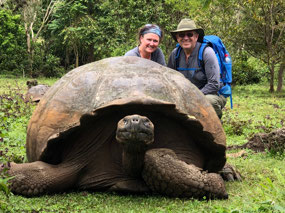
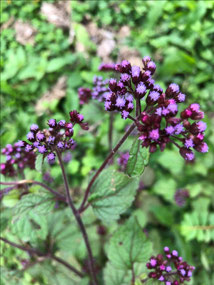
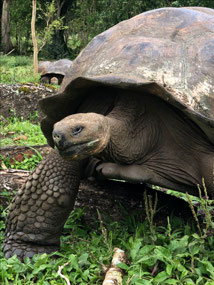





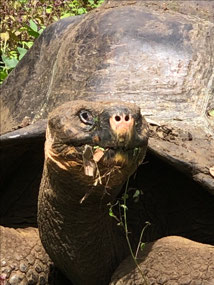

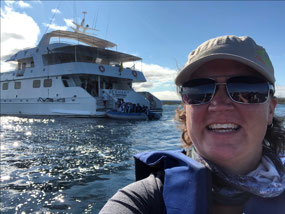
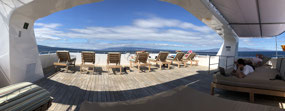
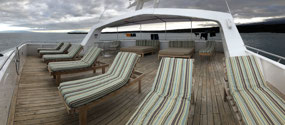
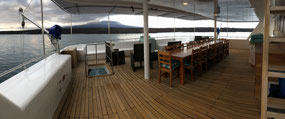
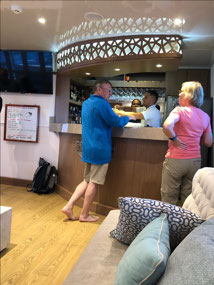
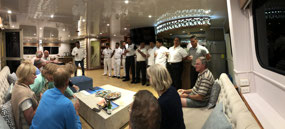
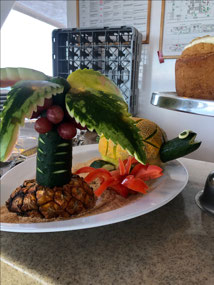
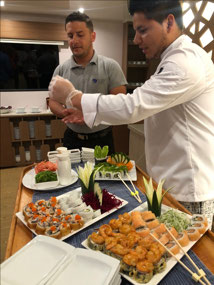
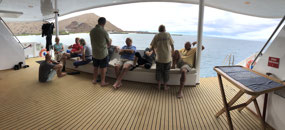
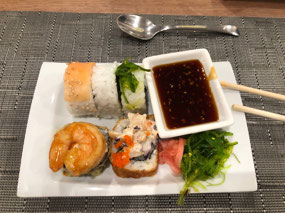
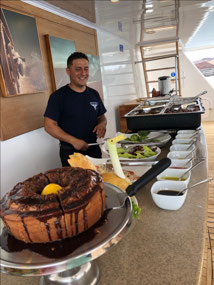
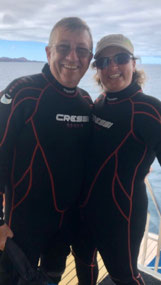
Diane Davis
2019-11-20
Sure hope you sold them all CFA tickets. This is amazing stuff my dear! Safe and fun travels. Ox
Jill
2019-11-20
Wow. What a time you’re having! Thanks for continuing to share your adventures with us.
Kellie
2019-11-20
I am amazed! I feel like I’m in National Geographic with a Newfoundland twist as I follow your journey! I love it !
Patti
2019-11-20
Amazing...the smiles says it all!
Lee Anne
2019-11-20
LOVE LOVE LOVE that gentle giant! ❤❤
Barb
2019-11-22
I just want to say WOW!
Susan
2019-11-23
Wow, what an amazing place to explore! Food looks incredible!
Susan
2019-11-23
Also, the pic of you and Paul in scuba gear! #rockstars